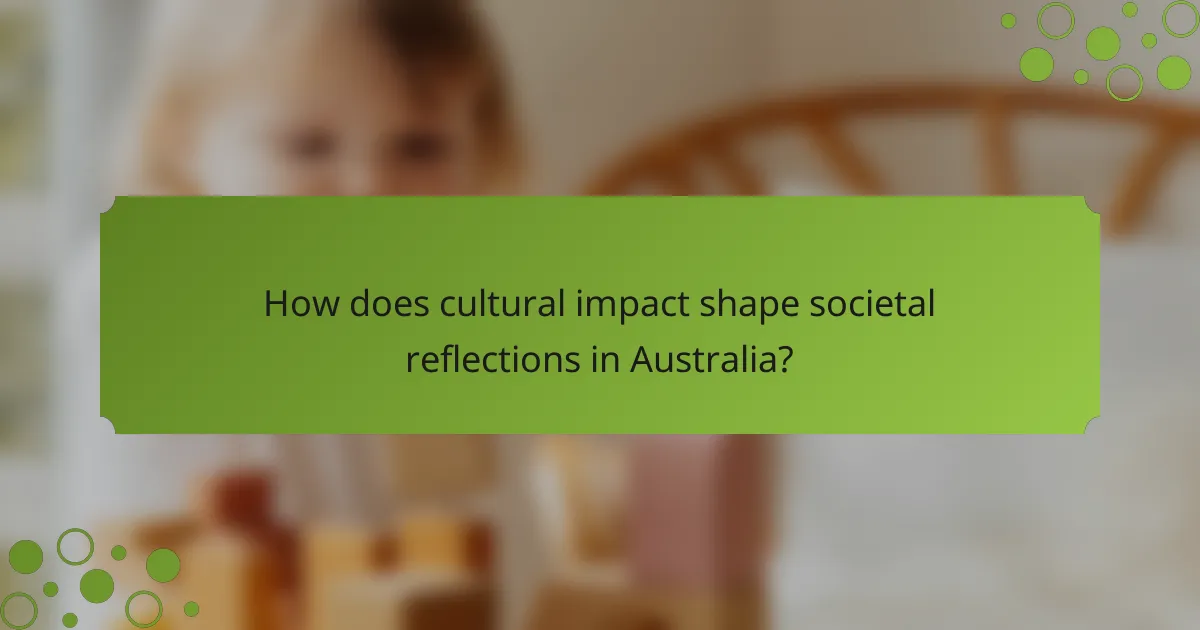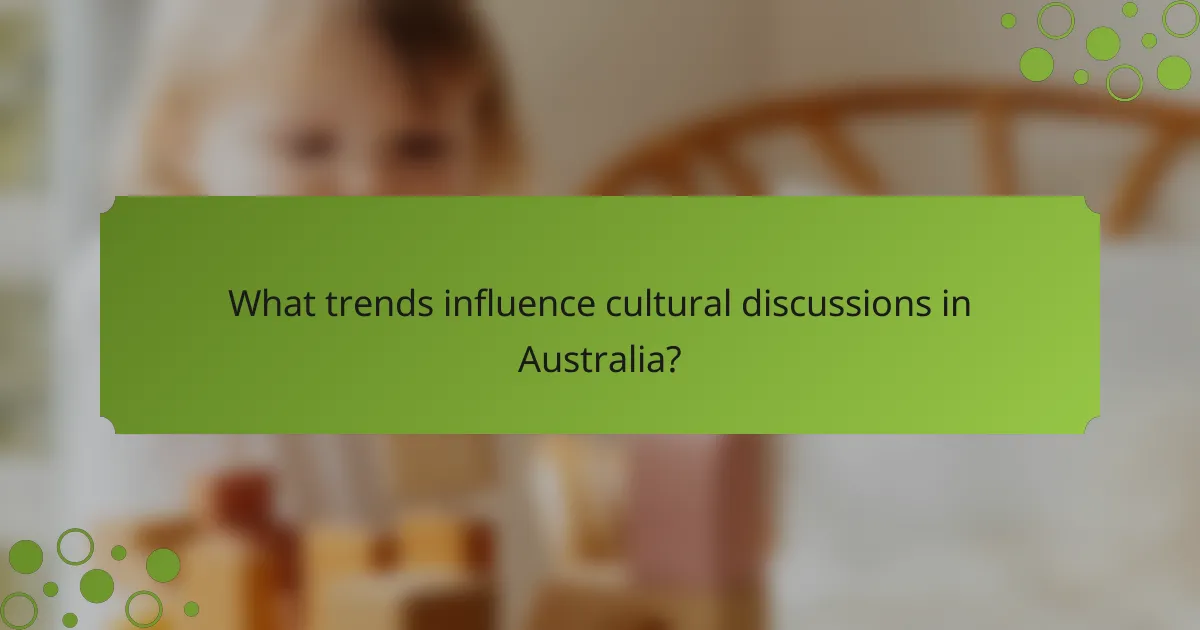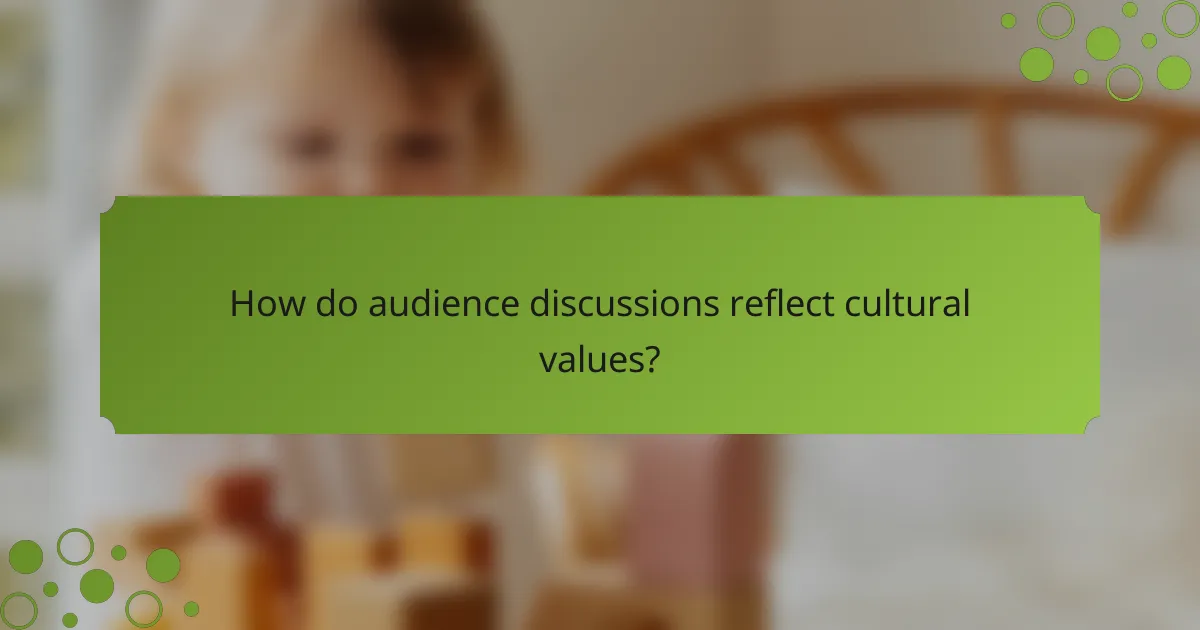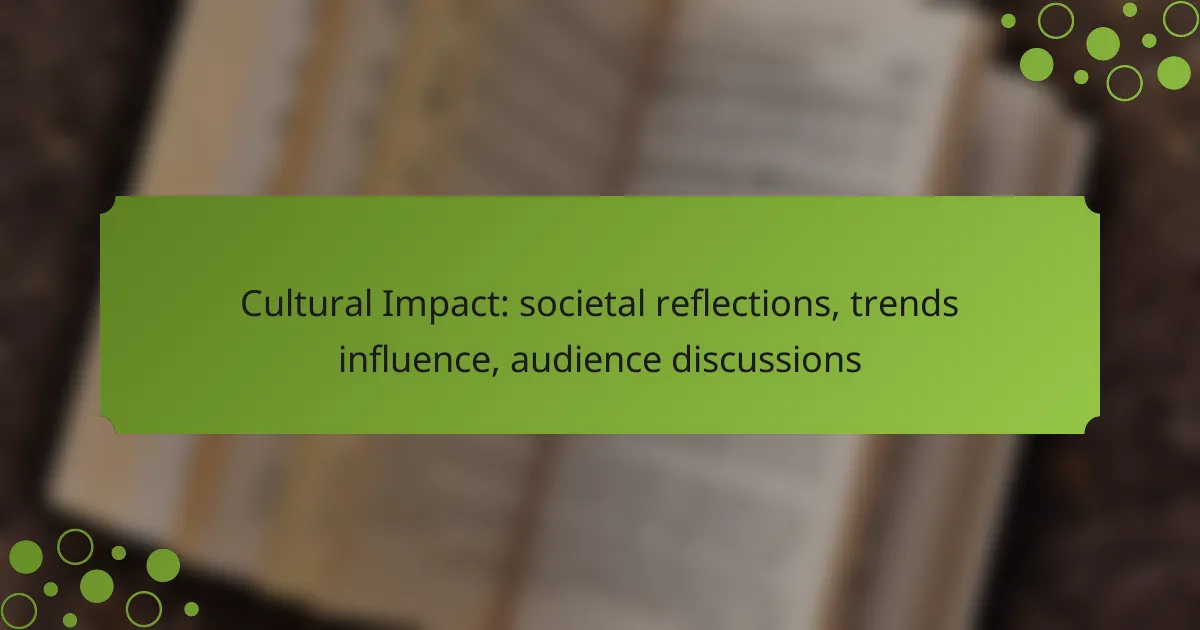The cultural impact in Australia plays a crucial role in shaping societal reflections, influencing values and behaviors within communities. As social media, environmental movements, and multiculturalism gain prominence, they significantly affect public discourse and the way Australians engage with diverse cultural expressions.

How does cultural impact shape societal reflections in Australia?
Cultural impact significantly shapes societal reflections in Australia by influencing values, beliefs, and behaviors within communities. This interplay fosters a dynamic environment where diverse cultural expressions contribute to the national identity and social cohesion.
Influence of Indigenous culture
Indigenous culture plays a crucial role in shaping societal reflections in Australia by promoting a deeper understanding of the land and its history. The recognition of traditional practices, languages, and art forms enriches the cultural landscape and encourages respect for the environment.
Programs that incorporate Indigenous perspectives in education and public discourse help bridge gaps between communities, fostering reconciliation and mutual respect. Celebrating events like NAIDOC Week highlights the importance of Indigenous contributions to Australian society.
Impact of immigration on societal norms
Immigration has a profound impact on societal norms in Australia, introducing new customs, languages, and traditions. The influx of diverse populations has led to a multicultural society where various cultural practices coexist and influence mainstream Australian culture.
For example, food, festivals, and art from immigrant communities have become integral to Australian life, enriching social interactions and broadening perspectives. However, challenges such as integration and social cohesion must be addressed to ensure a harmonious society.
Role of media in shaping perceptions
The media plays a pivotal role in shaping public perceptions of cultural impact in Australia. Through news coverage, documentaries, and social media, the media influences how cultural issues are understood and discussed among the population.
Representation matters; positive portrayals of diverse cultures can foster acceptance and appreciation, while negative stereotypes can perpetuate division. Media literacy initiatives can empower audiences to critically engage with cultural narratives and promote a more inclusive dialogue.

What trends influence cultural discussions in Australia?
In Australia, cultural discussions are significantly influenced by the rise of social media, environmental movements, and the effects of multiculturalism. These trends shape public discourse and reflect societal values, impacting how Australians engage with various cultural expressions.
Rise of social media platforms
The rise of social media platforms has transformed how Australians communicate and share cultural content. Platforms like Instagram, Facebook, and TikTok enable rapid dissemination of ideas, trends, and artistic expressions, allowing for a more interactive cultural dialogue.
Social media also democratizes content creation, giving voice to diverse perspectives that may not have been represented in traditional media. This shift encourages discussions around identity, representation, and social issues, fostering a more inclusive cultural landscape.
Impact of environmental movements
Environmental movements play a crucial role in shaping cultural discussions in Australia, particularly regarding sustainability and climate change. Activism around these issues has led to increased awareness and engagement in cultural practices that prioritize ecological responsibility.
For instance, art and literature often reflect themes of nature conservation and climate activism, prompting audiences to consider their environmental impact. Events like Clean Up Australia Day and the rise of eco-friendly festivals further highlight these cultural shifts.
Effect of multiculturalism on art and literature
Multiculturalism significantly enriches Australian art and literature, introducing a variety of cultural narratives and artistic styles. The blending of different cultural influences fosters creativity and innovation, resulting in a vibrant cultural scene that reflects the nation’s diversity.
Writers and artists from various backgrounds contribute unique perspectives, challenging dominant narratives and encouraging broader discussions on identity and belonging. This cultural dynamism not only enhances the richness of Australian arts but also promotes social cohesion through shared experiences and understanding.

How can online courses enhance understanding of cultural impact?
Online courses can significantly enhance understanding of cultural impact by providing structured learning experiences that delve into societal reflections, trends, and audience discussions. These courses often combine theoretical knowledge with practical applications, allowing learners to engage with diverse cultural perspectives.
Courses on Australian history and culture
Courses focusing on Australian history and culture offer insights into the nation’s unique identity and societal evolution. They typically cover key events, Indigenous cultures, and the influences of immigration, providing a comprehensive view of how these factors shape contemporary Australian society.
Many online platforms offer these courses, ranging from free introductory classes to more in-depth paid programs. For example, a course might explore the impact of the Gold Rush on Australian society or the significance of the Mabo decision in land rights discussions.
Workshops on cultural sensitivity
Workshops on cultural sensitivity are designed to improve understanding and respect for diverse cultural backgrounds. These sessions often include interactive activities that promote empathy and awareness, helping participants recognize their own biases and assumptions.
Typically, these workshops can vary in length from a few hours to several days and may include role-playing scenarios, discussions, and case studies. Organizations often seek these workshops to foster inclusive environments, making them valuable for workplaces and educational institutions alike.

What are the criteria for evaluating cultural trends?
Evaluating cultural trends involves assessing various factors that influence societal behavior and perceptions. Key criteria include demographic shifts, media representation, and audience engagement, which together provide insights into how trends develop and their broader impact on society.
Analysis of demographic shifts
Demographic shifts refer to changes in the composition of a population, including age, ethnicity, and socioeconomic status. These shifts can significantly influence cultural trends, as different groups bring unique perspectives and preferences that shape societal norms and values.
For instance, the increasing diversity in many countries has led to a greater emphasis on multicultural representation in media and arts. Understanding these demographic changes helps identify emerging trends and the potential for new cultural expressions.
Assessment of media representation
Media representation plays a crucial role in shaping cultural trends by influencing public perceptions and attitudes. Evaluating how different groups are portrayed in films, television, and social media can reveal underlying biases and gaps in representation.
For example, a lack of representation for certain demographics can lead to stereotypes, while inclusive media can foster acceptance and understanding. Monitoring media portrayal helps gauge the impact of cultural trends on societal attitudes and encourages more equitable representation.

How do audience discussions reflect cultural values?
Audience discussions serve as a mirror to cultural values, showcasing the beliefs, norms, and priorities of a society. These conversations can reveal what communities deem important, influencing trends and shaping public opinion.
Public forums and debates
Public forums and debates are essential platforms where individuals express their views on various issues, reflecting societal values. These discussions often highlight key topics such as social justice, environmental concerns, and economic policies, allowing participants to voice their opinions and engage with differing perspectives.
For example, town hall meetings or online discussion boards can showcase a community’s stance on local issues, revealing whether they prioritize sustainability or economic development. Engaging in these forums encourages critical thinking and fosters a sense of community involvement.
Role of influencers in shaping opinions
Influencers play a significant role in shaping audience opinions and reflecting cultural values through their platforms. By sharing their perspectives on social media, they can amplify certain issues and trends, impacting how their followers perceive and engage with these topics.
For instance, a lifestyle influencer promoting sustainable living can inspire their audience to adopt eco-friendly practices, demonstrating a shift towards environmental consciousness. However, it is crucial for audiences to critically evaluate the messages conveyed by influencers, as not all may align with genuine cultural values.

What emerging trends are reshaping cultural impact in Australia?
Emerging trends in Australia are significantly reshaping cultural impact by prioritizing sustainability, enhancing virtual experiences, and integrating technology into education. These shifts reflect a growing awareness of environmental issues, the need for accessible cultural engagement, and the role of innovation in learning.
Increased focus on sustainability
In Australia, there is a heightened emphasis on sustainability within cultural practices and events. This includes the use of eco-friendly materials, waste reduction strategies, and promoting local artists who prioritize environmental themes in their work.
For instance, festivals are increasingly adopting sustainable practices, such as offering reusable cups and encouraging public transport. Organizations are also collaborating with Indigenous communities to incorporate traditional ecological knowledge into cultural programming.
Growth of virtual cultural experiences
The rise of virtual cultural experiences has transformed how Australians engage with art and heritage. Online platforms now offer access to galleries, performances, and workshops, making culture more accessible to diverse audiences.
During the pandemic, many institutions pivoted to digital formats, which allowed them to reach audiences beyond geographical limitations. This trend continues as organizations develop hybrid models that combine in-person and virtual offerings, catering to varying preferences.
Integration of technology in cultural education
Technology is increasingly integrated into cultural education, enhancing learning experiences through interactive tools and resources. Schools and cultural institutions are using digital platforms to teach history, art, and Indigenous cultures more effectively.
For example, augmented reality applications allow students to explore historical sites or artworks in immersive ways. This approach not only engages learners but also fosters a deeper understanding of cultural contexts and narratives.
